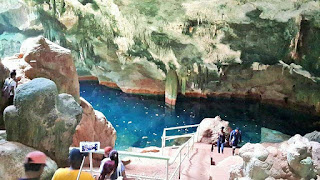 |
| 'Welcome to Gaspar Grande' |
The closest island to Chaguaramas Bay, up the northwestern archipelago, Gaspar Grande houses underground caves which were once used by pirates and smugglers for hidden treasures. Gasparee Caves, situated at Point Baleine on the northwestern end of Gaspar Grande Island, is one of Trinidad’s most popular tourist attractions.
 |
| Staircase leading inside |
Leading to the cave there is a concrete footpath, and the refurbished gunnery at the top of the hill. The journey begins at Point Baleine, ten minutes from the cave lodge, with the assistance of a tour guide to explore this natural wonder as the trail descends to the shimmering waters of the underground pool, in which is reflected the surrounding stalactites and stalagmites.
 |
| Pool inside cave |
Its unique translucent blue pond, which has an average depth of 10-20 feet is what makes this cave so appealing. Seawater emerges through an underground source into the cave to create this natural pool.
 |
| Overview of cave |
 |
| Cave formations |
Due to the wave action, acidic rainfall and percolating ground-water, the limestone has been dissolved, forming sculptured caverns, caves and sinkholes which make up Gasparee Caves. Gasparee Caves are approximately 90 feet deep, with the underground limestone system consisting of three main areas: The Entrance, The Twilight, and the Dark Zone. In each, fascinating geological formations are enhanced by natural light reflections. The Twilight Zone also has a saline pool, three feet deep at its shallowest.
 |
| War cannon |
Some fascinating creatures found at this site are bats in the cave, the yellow-headed parrot, rufus-necked wood rail and pelicans.
Additionally, a trek across Gaspar Grande will lead to a World War II cannon originally mounted for the defence of the bay. Finally, before returning to Chaguaramas, a boat trip can be taken around the tip of the mainland to Scotland Bay for a soothing sea bath.
The Tourist Development Company of Trinidad and Tobago restored the cave to accommodate visitors with an inside staircase and supplied electricity. The cave is managed by the Chaguaramas Development Authority (CDA) who conducts daily tours to the Island.
Geography Facts:
- Island’s geological features consist of limestone which is sedimentary rock formed under the sea and composed of coral, oolites, seashells and other marine creatures.
- The cave originated when water deposits of carbon dioxide dissolved the limestone into crystals of calcium carbonate, a chemical formula known as CaCO3 which is a compound of calcium, carbon and oxygen.
- Over time, the accumulations of crystals create stalagmites, which extend up, from the cave floor, and stalactites extend down from the roof. Those that stem all the way from the ceiling to the ground are called pillars. Some of the crystals transform into fascinating shapes, resembling a dinosaur head, a chandelier, two lovers hugging and even flowers.
Historical Facts:
- In 1783, Governor Don Jose Maria Chacon granted the island to Gaspar De Percin Roque to plant cotton.
- 1826 to 1864 - a flourishing whaling station was established at Point Baleine or Whale Point. When the whaling industry declined, Cannings of the Queens Park Hotel acquired the land and built a luxurious hotel at Point Baleine.
- During World War II (1939-1945) the Americans occupied the island and at its highest point 399 feet, where there are historical guns built as a defence against enemy attack.












































